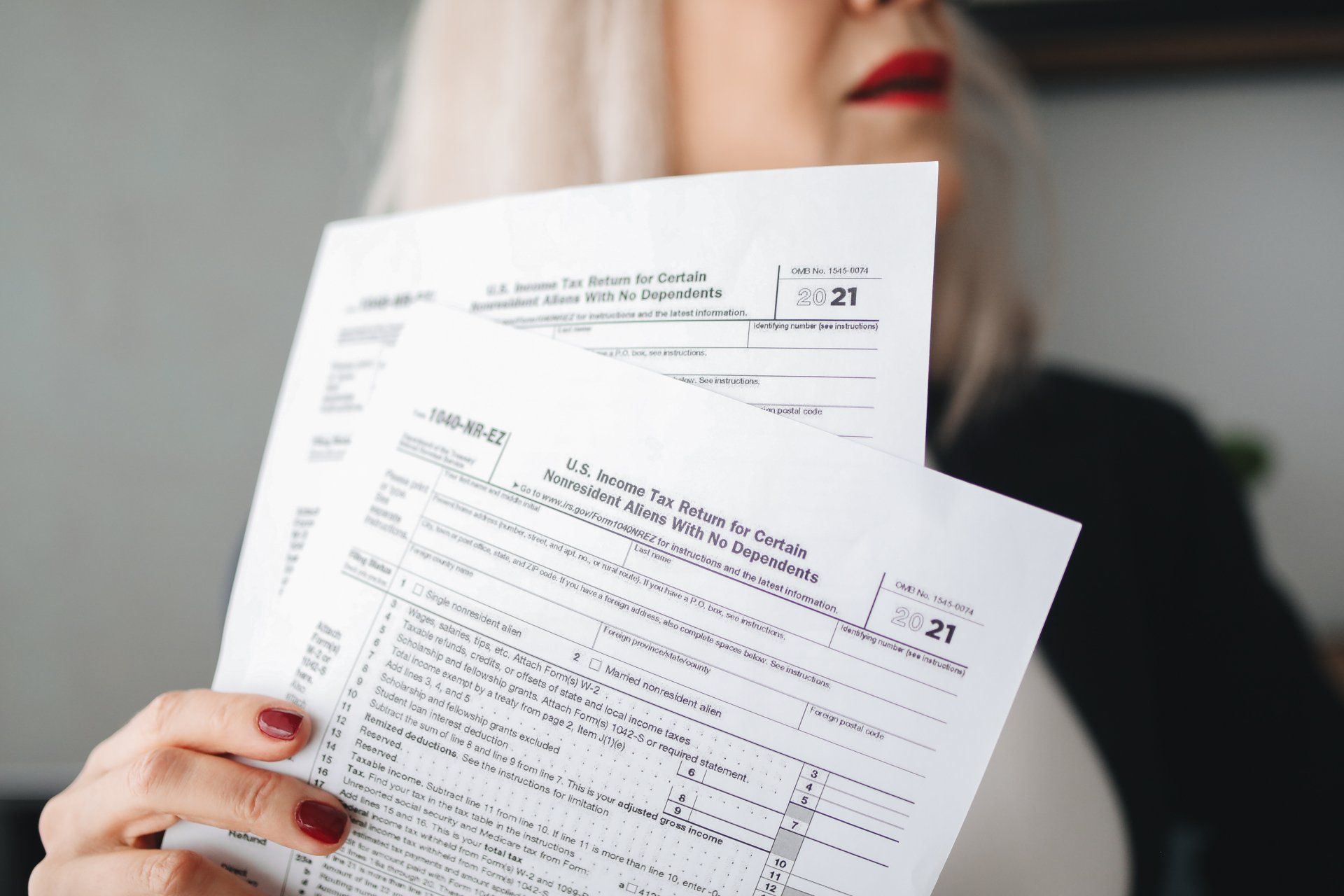O que esperar da sua entrevista N-400
Santos Lloyd Law Team • October 13, 2023
Click here to read this article in English
Você chegou ao final da sua jornada para se tornar um cidadão americano - você teve seu green card pelo tempo necessário, e completou e enviou com sucesso seu formulário N-400 para finalmente se candidatar a se tornar um cidadão americano. Você acabou de receber o aviso de entrevista do N-400 pelo correio, mas o que acontece nessa entrevista?
A entrevista do N-400 consiste em duas partes separadas: um teste e uma entrevista propriamente dita. Abaixo, vamos detalhar cada parte:
- Parte I - Teste de Naturalização
A primeira parte da sua entrevista do N-400 consistirá em um teste. O teste é composto por dois componentes: inglês e cívica. Durante a parte de inglês do teste, você deve demonstrar que entende o idioma inglês e que tem a capacidade de ler, escrever e falar inglês básico. O oficial vai pedir que você leia corretamente uma frase em voz alta e também vai pedir que você escreva corretamente uma frase.
Durante o teste cívico, você vai responder a perguntas importantes sobre o governo e a história americana. Há uma lista de 100 possíveis perguntas que o oficial pode fazer a você. No entanto, o oficial só fará 10 perguntas durante sua entrevista, e você só precisa responder corretamente a 6 dessas perguntas para passar.
- Parte II - Entrevista de Naturalização
Depois de passar no seu Teste de Naturalização, o oficial vai informar que você passou no teste e vai passar para a entrevista de Naturalização. Durante esta entrevista, o oficial vai revisar seu pedido de N-400 com você. O oficial vai verificar se todas as informações listadas no formulário estão corretas e vai corrigir quaisquer erros ou atualizações no formulário. O oficial também vai revisar seu histórico de viagens durante os últimos 5 anos. É importante que você saiba sua data de saída dos EUA, sua data de retorno aos EUA, qual país você visitou e qual foi o propósito da sua visita. Por fim, você vai revisar as questões de segurança e as questões constitucionais no formulário juntos com o oficial.
O que acontece depois que eu passo no teste e completo a entrevista?
Dependendo do escritório em que sua entrevista está agendada, você pode se tornar um cidadão americano no mesmo dia! Alguns escritórios oferecem cerimônias de naturalização no dia em que você completa com sucesso sua entrevista, mas você terá que perguntar ao oficial se esse serviço está disponível. Se não estiver, não se preocupe - você será agendado para retornar para uma cerimônia de naturalização. Na cerimônia de naturalização, você fará um juramento de fidelidade e receberá seu certificado oficial de naturalização. É muito importante manter seu green card até que seu certificado de naturalização seja emitido. Na cerimônia de naturalização, um oficial explicará o processo para obter um número de segurança social e um passaporte.
E se eu não passar no teste cívico?
Se você não passar no teste cívico na primeira tentativa, a imigração (USCIS) remarcará seu horário e você voltará em outro dia para refazer o teste. É muito importante estudar, pois você só tem 2 tentativas para fazer o teste de inglês e cívico. Você pode encontrar as 100 possíveis perguntas que o oficial pode fazer a você neste link:
Este blog não se destina a fornecer aconselhamento jurídico e nada aqui deve ser interpretado como estabelecimento de um relacionamento advogado-cliente. Por favor, agende uma consulta com um advogado de imigração antes de agir com base em qualquer informação lida aqui.
Similar Posts

To be eligible for U.S. naturalization based on being a lawful permanent resident for at least five years, you must: Prove you have been a lawful permanent resident of the U.S. for at least five years; Demonstrate continuous residence in the U.S. for at least five years immediately before applying for naturalization; Show you have been physically present in the U.S. for at least 30 months out of the five years immediately before applying for naturalization; and Pass the naturalization test. The naturalization test consists of the English and civics test. The applicant must show his/her ability to read, write, and speak basic English. The interviewing USCIS officer will ask the applicant to read a sentence in English and to write a sentence in English. If the applicant demonstrates his/her ability to read, write, and speak English, the applicant passes this portion of the test. The civics test is an oral test, and the applicant is asked questions about the American government and history. The USCIS officer will ask the applicant up to 10 questions from the list of 100 civics test questions. To pass this portion of the test, the applicant must answer at least 6 questions correctly. If the applicant satisfies all of the eligibility requirements and passes the naturalization test, the last step before naturalizing is to attend the oath ceremony to become a naturalized U.S. citizen. If you have any questions and would like more information about your eligibility for naturalization, please contact our office to schedule a consultation with our experienced immigration attorneys.

U.S. Citizenship and Immigration Services made changes to the naturalization application and the filing fee which became effective April 1, 2024. The naturalization application, Form N-400, was updated. The new form edition is dated 04/01/2024. As of June 3, 2024, USCIS will only accept the new form edition. The filing fee for Form N-400 also changed. The prior filing fee was $640.00 plus a biometric fee of $85.00, for a total of $725.00. The new filing fee became effective April 1, 2024, so all naturalization applications postmarked April 1, 2024, or later, must include the new appropriate filing fee. The new general fee if you file a paper application is $760.00, and if you file the application online the fee is $710.00.

The Military Selective Service Act requires all men living in the United States to register with the Selective Service System within 30 days of turning 18 years old and up to 26 years of age. The Selective Service System (SSS) is used by the U.S. government to draft soldiers into service during times of war. There are a few exceptions to the registration requirement: First, if you hold non-immigrant status until the age of 26, you do not have to register with the SSS. Second, if you enter the U.S. after the age of 26, you do not have to register with the SSS, as the age requirement to register is between 18 and 26. Third, men born after March 29, 1957, and before December 31, 1959, are not required to register. To verify online go to: https://www.sss.gov/verify/ . The information you will need to provide is your last name, social security number, and date of birth. If you find your registration record, download, and print an official Selective Service Registration Acknowledgement Letter from the website and include it with your application. This is sufficient to show that you registered. If you can’t verify your registration because you don’t have a social security number or you didn’t have one when you registered, or you prefer to call, you need to call the SSS at: (888) 655-1825 . Note, failure to register will not automatically lead to the U.S. Citizenship and Immigration Services denying your naturalization application. In fact, even if you did not register and you were required to do so, the USCIS cannot deny your application if you show that you did not know you were required to register, or the failure to register wasn’t intentional. If you have any questions, please schedule a consultation with one of our experienced attorneys and we will be more than happy to assist you.

When applying for a green card or seeking admission into the United States, one of the legal hurdles many applicants may face is the public charge ground of inadmissibility. This test evaluates whether someone is likely to become primarily dependent on the government for support. But what exactly does that mean—and what types of public benefits can trigger this issue? In this article, we’ll break down what “public charge” really means, who is affected, what types of public benefits are considered, and what immigrants should be mindful of when making decisions about public programs like Medi-Cal and Medicaid. What Is the Public Charge Ground of Inadmissibility? The public charge rule applies to individuals applying for a visa, green card (adjustment of status), or entry into the U.S., unless they fall into an exempt category. Under this rule, the Department of Homeland Security (DHS) must determine whether the applicant is likely to become primarily dependent on the government for subsistence. This typically refers to receiving: Public cash assistance for income maintenance (such as SSI or TANF), or Long-term institutional care at government expense. This determination is based on the "totality of circumstances," including age, health, financial resources, education, skills, and whether a sponsor has submitted a valid Affidavit of Support. Who Is Exempt from the Public Charge Rule? Many categories of immigrants are exempt from the public charge ground of inadmissibility. These include: Asylees and refugees Special immigrant juveniles Violence Against Women Act (VAWA) self-petitioners T and U visa applicants Temporary Protected Status (TPS) applicants Importantly, even if someone later adjusts status through a different pathway that is subject to public charge, any benefits they received while in an exempt category will not be held against them. What Public Benefits Are Not Considered in the Public Charge Test? It is a common and harmful myth that using any public benefit will jeopardize your immigration status. In fact, most non-cash benefits do not count against you in a public charge determination. According to USCIS and DHS guidance, the following types of assistance (current as of July 1, 2025) are not considered: Health-Related Benefits Medi-Cal/Medicaid, except for long-term institutional care Children’s Health Insurance Program (CHIP) Health insurance through the ACA Marketplace, including subsidies COVID-19 testing, vaccines, and treatment Community health services, crisis counseling, and short-term shelters Food and Nutrition SNAP (Food Stamps) WIC School meal programs Food banks and emergency food assistance Housing and Energy Emergency shelter Rental assistance (e.g., McKinney-Vento programs) Energy assistance (e.g., LIHEAP) Education and Childcare Public schooling Head Start Childcare subsidies (e.g., CCDF) Educational grants and scholarships Federal Cash and Tax Benefits Earned income tax credit (EITC) Child Tax Credit (CTC) Stimulus checks Unemployment insurance Social Security and veteran’s benefits Disaster and pandemic-related cash aid In short, just because a benefit is public or government-funded doesn’t automatically make it count against you. A Word of Caution About Medi-Cal and Medicaid, in Particular As of today (07/01/2025), standard use of Medi-Cal (California’s version of Medicaid) or Medicaid for most health-related services is not considered in a public charge determination. This includes preventative care, emergency services, pregnancy-related services, and short-term care. However, if Medicaid is used for long-term institutionalization, such as in a nursing home or psychiatric facility, that does count under the public charge test. Despite current guidance, we are seeing political shifts and changes in tone from the current administration that suggest public charge policies may become more restrictive in the future. This includes renewed interest in expanding the types of public benefits that may be considered, particularly around medical assistance. For that reason, we generally recommend that individuals who are applying for adjustment of status, or who may be subject to the public charge ground in the future, avoid enrolling in Medi-Cal or Medicaid at this time, unless absolutely necessary. Final Thoughts Immigration law is complex, and the rules surrounding public charge can feel confusing or even frightening. But it’s important to understand that using most public benefits—especially for food, education, and healthcare—will not automatically jeopardize your green card or visa application. Still, because policy can change quickly, we urge individuals to consult with an immigration attorney before applying for any public assistance—especially healthcare programs like Medi-Cal or Medicaid. If you have questions or concerns about how public benefits might impact your immigration case, our office is here to help. We are committed to providing up-to-date, personalized guidance to keep your immigration journey on track. Disclaimer The information provided herein is for general informational purposes only and does not constitute legal advice. Every immigration case is unique, and the application of the public charge rule may vary depending on your specific situation. If you believe this topic may apply to you or you need individualized legal guidance, we encourage you to contact one of our highly-qualified legal professionals for a consultation and assistance tailored to your circumstances. Resources: USCIS Public Charge Resources ILRC Medi-Cal and Public Charge Alert (2024) California Medi-Cal Immigrant Eligibility FAQ

As an immigration law firm, we regularly assist highly skilled professionals working in the U.S. on temporary work visas such as H-1B who are seeking a path to permanent residency. For many of these individuals, the EB-2 and EB-3 employment-based green card categories are the most pursued—and frequently misunderstood—routes . While both are viable pathways to permanent residency, they differ in meaningful ways that can significantly impact the timing, eligibility, and overall strategy of your case. The EB-2 category is intended for individuals who either hold an advanced degree or demonstrate exceptional ability in their field . Most applicants qualify by having a master’s degree (or higher), or a bachelor’s degree accompanied by at least five years of progressive experience in their profession. There is also a subcategory within EB-2 known as the National Interest Waiver (NIW), which allows qualified individuals to self-petition without employer sponsorship if their work substantially benefits the United States. This route is especially relevant for researchers, entrepreneurs, and professionals in high national interest or mission-critical fields. In contrast, the EB-3 category includes professionals with a bachelor’s degree as well as skilled workers with at least two years of training or experience . While the educational threshold for EB-3 may appear less rigorous, the process itself is equally structured. One key distinction between EB-2 and EB-3 lies in the requirements of the job being offered, not just the applicant’s own credentials. For example, if a position requires only a bachelor’s degree, even a highly qualified candidate with a master’s degree may still fall under EB-3. Regardless of which category applies, most employment-based green card cases begin with the PERM labor certification process . This is a formal procedure overseen by the U.S. Department of Labor, in which the employer must test the labor market and demonstrate that there are no able, willing, qualified, and available U.S. workers for the position. The employer must also agree to pay the prevailing wage as determined by the Department of Labor. This step is both mandatory and highly detail-sensitive; inaccuracies in the job description, recruitment steps, or wage determination can lead to significant delays or even denials. Once PERM certification is approved, the employer files Form I-140 , the Immigrant Petition for Alien Worker. This petition confirms that the employee meets the requirements for the offered position under either EB-2 or EB-3, and that the employer is financially capable of providing the job as described. If the employee’s priority date—which is based on the date the PERM was filed—is current according to the Department of State’s Visa Bulletin, the individual may then file Form I-485 to adjust their status to lawful permanent resident. One of the more nuanced aspects of this process involves understanding how priority dates and visa backlogs affect the timeline. For applicants from countries with high demand, such as India or China, significant delays are common—particularly under EB-2. Paradoxically, there are times when the EB-3 category moves faster, prompting some applicants to file a second I-140 under EB-3 while retaining the original priority date. This strategy can be effective but requires careful legal planning to ensure it’s done correctly. Another strategic factor is portability. If your I-485 application has been pending for at least 180 days and your I-140 has been approved, you may be eligible to change employers under the AC21 portability provisions, so long as the new job is in the same or a similar occupational classification. This flexibility can be critical for employees who experience job changes or promotions during the often lengthy green card process. Ultimately, the choice between EB-2 and EB-3 isn’t about prestige —it’s about aligning your qualifications, the job requirements, and your immigration history with current legal standards and market conditions. The right strategy depends not only on your education and experience, but also on your long-term career goals and country of origin. At our firm, we work closely with both employers and employees to develop individualized immigration strategies that streamline the process and avoid unnecessary setbacks. Whether you're a corporate professional evaluating your green card options or an employer preparing to sponsor a key team member, we offer the insight and experience to move your case forward with confidence.

If you've made it to the United States as a culinary professional—perhaps on an O-1B visa that recognizes your extraordinary talent, or a P-3 visa for sharing your rich culinary heritage—congratulations! You’ve already proven yourself as a standout in your craft. But what if we told you that your journey doesn’t have to end when your temporary visa does? In fact, your current status could be the perfect stepping stone to something much more lasting: a green card through the EB-1A category. The EB-1A visa is a first-preference employment-based immigrant visa, designed for individuals with “ extraordinary ability ” in fields such as the arts, sciences, education, business, or athletics. And yes—culinary arts absolutely count. The key is demonstrating that your skills have risen to the very top of your field. If you've already gone through the O-1 or P-3 process, you're likely well on your way . Here’s the good news: much of the evidence used to obtain your O-1B or P-3 visa can be repurposed for your EB-1A petition . Awards, press features, expert testimonials, and proof of your work in prestigious kitchens or at cultural events—they're all valuable again. But what’s even more exciting is that everything you’ve accomplished while in the U.S. on your temporary visa—whether launching a signature tasting menu, starring in a food documentary, or leading culinary workshops—can now be used to further strengthen your case. According to USCIS, EB-1A applicants must meet at least three of ten criteria unless they’ve received a major internationally recognized award. These criteria include things like published material about your work, original contributions of major significance, high salary, and a critical role in distinguished organizations. For many chefs, especially those who’ve thrived in the U.S. hospitality scene, it’s absolutely achievable with the right guidance. What sets the EB-1A apart is that it does not require an employer sponsor . That’s right—you can self-petition! This means your culinary career can be as flexible and entrepreneurial as you want it to be, whether that means opening your own restaurant, expanding into media, or continuing to cook your way into America’s heart. Even better? It can be one of the fastest paths to a green card available. With premium processing, your I-140 petition can be adjudicated within just 15 business days. And if your country’s EB-1 visa category is current on the visa bulletin at the time of approval, you may be eligible to file your green card application immediately. This combination of speed, autonomy, and flexibility makes EB-1A an incredibly attractive next step in your immigration journey. At Santos Lloyd Law Firm, we love helping creative professionals take their next big step. If you’ve already wowed the world with your cuisine, the EB-1A may be your opportunity to stay and make your mark for good. Contact us today to find out if the EB-1A is the next right step for you!



